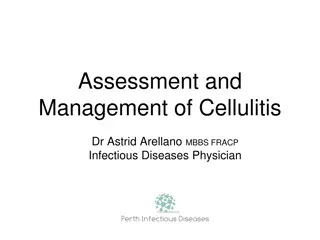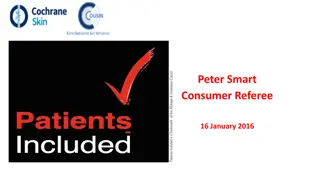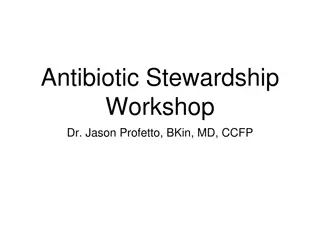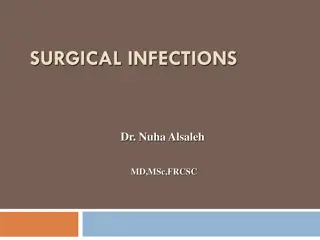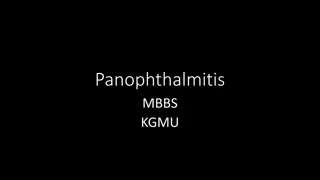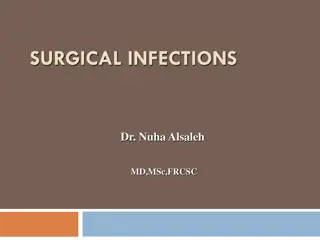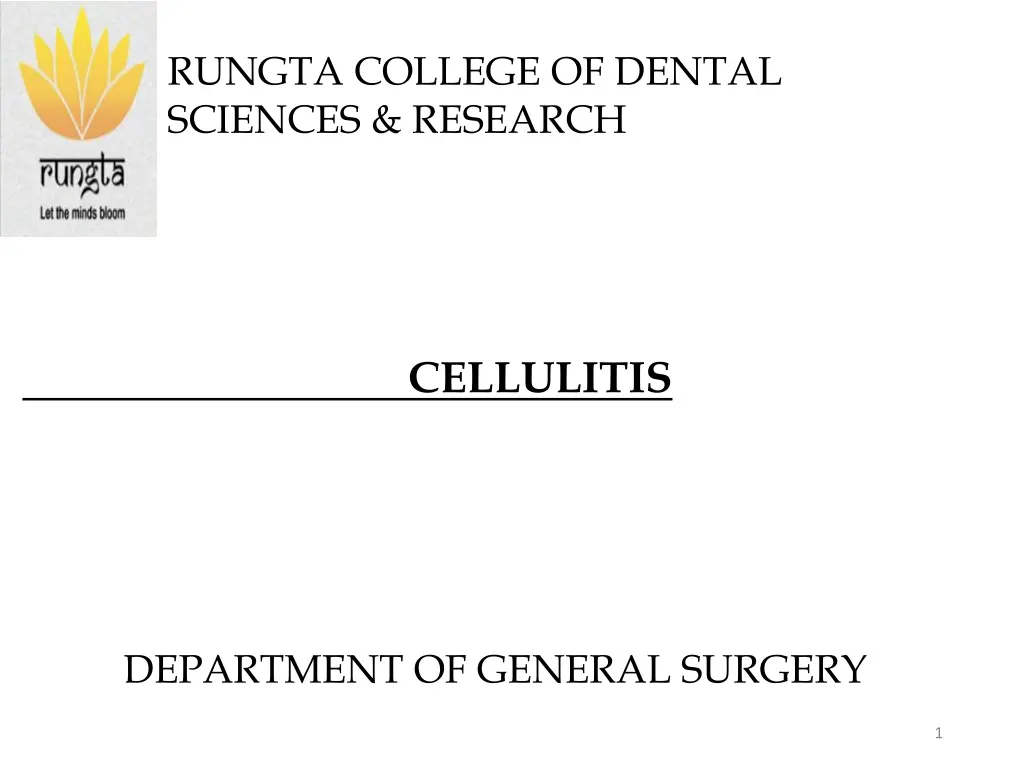
Cellulitis and Erysipelas: Causes, Symptoms, and Treatment
Learn about cellulitis and erysipelas, two types of skin infections caused by bacteria. Explore the causes, symptoms, common sites, clinical features, treatments, and complications associated with these conditions. Enhance your knowledge on how to manage and prevent cellulitis and erysipelas effectively.
Download Presentation

Please find below an Image/Link to download the presentation.
The content on the website is provided AS IS for your information and personal use only. It may not be sold, licensed, or shared on other websites without obtaining consent from the author. If you encounter any issues during the download, it is possible that the publisher has removed the file from their server.
You are allowed to download the files provided on this website for personal or commercial use, subject to the condition that they are used lawfully. All files are the property of their respective owners.
The content on the website is provided AS IS for your information and personal use only. It may not be sold, licensed, or shared on other websites without obtaining consent from the author.
E N D
Presentation Transcript
RUNGTA COLLEGE OF DENTAL SCIENCES & RESEARCH CELLULITIS DEPARTMENT OF GENERAL SURGERY 1
Specific learning Objectives At the end of this presentation the learner is expected to know ; Core areas* Domain ** Category # Cognitive Must Know Cellulitis Erysipelas Ludwig's Angina Boil Carbuncle Necrotizing Fasciitis Cognitive Must Know Cognitive Must Know Cognitive Must Know Cognitive Must Know Cognitive Must Know 2
Table of Content Erysipelas Ludwig's Angina Boil Carbuncle Necrotizing Fasciitis 3
CELLULITIS It is a spreading subcutaneous inflammation. Causetive agent-Haemolytic streptococcus. Bacteria produces two enzymes- 1.Hyaluronidase 2.Streptokinase
Common sites- Face Scrotum Fore arm & leg Sources of infection(due to break in skin barrier) Injuries-minor or major Scratches on skin Insect ,scorpion or snake bite. Pre-disposing factors- Diabetes,Malnourished,Low immunity.
Clinical features- Affected part - diffuse swelling -redness & shiny -painful & itching Systematically- fever pain May develop toxaemia. In untreated cases-Suppuration,sloughing and gangrene may occur.
Treatment- 1.Bed rest and part is elevated. 2.Glycerin magsulf dressing 3.Diabetes control 4.Appropiate antibiotic- Inj. Crys.penicillin 10 lakh unit 6hrly5-7day or Ciprofloxicin 500 mg twice a day. 5.Anti-snake venom in snake bite cases.
Complication- 1.Suppuration and abscess formation. 2.Necrotising fascitis 3.Toxaemia and septicaemia. 4.Ketoacidosis in diabetes. *********
ERYSIPELAS It is an acute infection of upper dermis of skin and superficial lymphatics caused by beta- haemolytic group of streptococci. It is more superficial than cellulitis. Surface is raised and well demarked.
Precipitating factors- * malnourishment, * Chronic diseases, * Children & old people Onset- After a small scratch or abraison, it spreads quickly resulting in toxaemia. Common sites- Face, eyelids, forearm, scrotum.
Clinical features- 1.Rose pink rashes with raised edges having consistency of button hole. 2.Vesicles appear later,rarely pustular. 3. Oedema and toxaemia may be seen. 4. Milian s ear sign is positive. Complication- 1.Toxaemia and septicaemia 2.Gangrene of skin and subcuteneous Tissue. 3. Lymphodema of face and eyelid due to obstruction to lymphatic drainage. Treatment-1.Appropriate antibiotic -2.Symptomatic trt. For aches & fever 3.Saline wet dressing 4.Elevation of limb and rest to the part. 5.Hydration by IV infusion 6.Careful monitoring of patient.
LUDWIG ANGINA DEFINITION- It is an acute inflammation of submental and sub mandibular region associated with oedema of floor of the mouth. Agent- Virulent streptococcal organism -Anaerobic organism. Precipitating factors- 1.Caries tooth 2.Cachexia 3.Chronic diseases-(diabetes) 4.Calculi in submandibular gland 5.Cancer of the oral cavity 6.Chemotherapy.
Clinical features- * Diffuse swelling in submental and submandibular region with brawny oedema. * Oedema of the floor of the mouth which pushes tounge upwards causing difficulty swallowing. * Putrid halitosis * High grade fever with toxicity.
MANAGEMENT- It is a serious condition and timely care and treatment is essential. 1. Hospitalisation 2. Intravenous infusion and correction of dehydration. 3. In some cases,Ryle s tube feeding and oxygen may be required. 4. Antibiotic-broad spetrum 5. Oral hygiene to be improved. 6. Treatment of the associated co-morbidity Surgery- *Under general anaesthesia * 5-6 cm curved incision below mandible * Submandibular gland is mobilised, *Mylohyod muscle is divided and pus is drained. * Wound is closed with loose sutures after irrigation. *A drainage tube is kept in place.
BOIL BOIL
It is an hair follicle infection usually secondary to sebaceous gland infection. Causative agent- Staphylococcus aureus Clinical features- Swelling indurated,painful oedema and redness, After 1-2 days, it softens and thereafter it burst spontaneous. Pus comes out as discharge.
Some interesting facts about Some interesting facts about boil boil- - 1.Most painful boil- external meatus 2.Most dangerous boil- dangerous area of face 3.Sweet boil- seen in diabetic patient 4.Dull boil- no suppuration 5.Boil like- oily skin
COMPLICATIONS 1.Necrosis of skin 2.Septicaemia and toxemia 3.Cavernous sinus thrombosis 4. Meningitis or brain abscess. ***
TREATMENT Incision and drainage with excision of slough. Suitable antibiotics and analgesics/antipyratics. ***
CARBUNCLE Image result for carbuncle
It is a infectious gangrene of skin and subcutaneous tissue. It is cluster of boils. Causative agent: staphylococcus aureus Predisposing factor: I. Diabetic patient II. Obese III. Poor and malnourished people IV. People with poor immunity
Common site : I. Nape of neck. II. Back. III.Shoulder region. IV.Places where friction of hair occur due to clothing or furniture .
Pathology: Starts as folliculitis Perifolliculitis Necrosis of subcutanious tissue and fat Multiple abscess formation intercommunicating Open exterior and discharge pus Multiple pus discharging opening give sieve like opening.
Clinical feature: I. II. Multiple pus discharge opening cribriform appearance. III. Surface is red,angry looking. IV. Surrounding indurated . V. Crateriform ulcerformation. VI. Fever. VII.Bodyache. VIII.Malaise. Severe pain and swelling of part.
Complications: I. Extensive necrosis of overlying skin. II. Septicaemia and toxaemia. III.Worsening of diabetic status.
Treatment: General treatment: Surgical treatment: Controlling diabetes Antibiotics after pus culture MRSA: vancomycin i.v infusion if required Analgesic and Antipyretic Surgery is required when there is pus Cruciate excision is given All septas are broken
POTTS PUFFY TUMOUR It is the formation of diffuse external swelling in scalp due to subperiosteal pus formation and scalp oedema.
CAUSES 1.Frontal sinusitis which suppurates and extend to subperiosteal region. 2. Trauma causing frontal haematoma. 3. Chronic otitis media.
CLINICAL FEATURES 1.pain,swelling 2.tender,warm 3. Toxic look ,drowsiness. COMPLICATIONS 1. Osteomylitis of frontal bone. 2. Spread of infection into the cranial cavity,extra dural and subdural abscess.
Investigation CBC ESR X-RAY CT-SCAN Treatment- 1.Under antibiotic coverage drainage of pus under GA. 2. Infection entering to cranial cavity- treated according to surgery. 3. osteomylitis of frontal bone may need radical removal and reconstruction. ***
NECROTISING FASCITIS It is also known as flesh eating disease. It is a very serious disease. It is a fast spreading ,destructive and invasive infection of skin and soft tissue involving deep fascia too but rarely involves skeletal muscles.
Common sites- *Genitalia * Lower abdomen * Perineum * Limbs Types- * Mono-microbial or(Type-2 necrotising -fascitis)caused by group A beta haemolytic streptococci. * Poly-microbial or (type-1 Necrotising fascitis ) It is due to synergistic combination of multiple bacterial infection including non-group A haemolytic streptococci and anaerobes.
Clinical features- * sudden pain and swelling of affected part. * Red and oedematous skin. * Skip lesion of necrosis and ulcerations. * High fever,signs of toxaemia and septica- -emia and may have jaundice,renal failure. Diagnosis- * Full thickness biopsy * Watery discharge(dishwater liquid) is chara- -cteristic.
Treatment- 1.Hospitalisation 2.Adequate hydration 3.Broad spectrum antibiotic Surgery-Wide excision,generous debri- -dement followed by skin graft after few days. Note- In type 2 necrotising fascitis-high dose of penicillin along with CLINDAMYCIN is treatment of choice.Clindamycin prevents synthesis of toxins. ********
REFERENCES SRBS BOOK OF GENERAL SURGERY A MANUAL ON CLINICAL SURGERY - S DAS MANIPAL MANUAL OF SURGERY - K RAJGOPAL SHENOY BAILEY AND LOVES SHORT PRACTICE OF SURGERY 43
Question & Answer Session You may ask your doubts related to the topic? 44
THANK YOU 45

